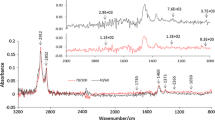Abstract
Refractive indices of seven bitumen samples and three aggregates (typical components in flexible asphalt pavement) were determined by ellipsometry in order to predict dispersive bitumen–aggregate adhesion and dispersive bitumen–bitumen cohesion using Hamaker’s constant. Hamaker’s constant according to Lifshitz was introduced to the asphalt field by two of the authors to describe and estimate van der Waal’s interaction and bitumen–aggregate adhesion. Lifshitz used the refractive index to estimate the dispersive non-polar van der Waal’s interaction component of adhesion, the predominant component in adhesion between minerals and bituminous binder. The impact of an intervening thin medium such as air or water on the adhesion can be estimated using Hamaker’s coefficient, which in turn can be related to stripping potential. The bitumen binders studied were delivered as a paving grade 70/100 according to EN 12591:2009 and came from different bitumen suppliers. The three aggregates studied were two types of granite and one diabase. It is concluded from the measurement of refractive indices and calculations of the dispersive component of Hamaker’s constant that there was a larger spread in refractive index among the three aggregate samples studied than among the seven bitumen samples.


Similar content being viewed by others
References
Ensley EK (1975) Multilayer adsorption with molecular orientation of asphalt on mineral aggregate and other substrates. J Appl Chem Biotechnol 25:671–682
Ensley EK, Petersen JC, Robertson RE (1984) Asphalt–aggregate bonding energy measurements by microcalorimetric methods. Thermochim Acta 77:95–107
Redelius PG (2000) Solubility parameters and bitumen. Fuel 79:27–35
Redelius PG (2006) The structure of asphaltenes in bitumen. Road Mater Pavement Des (special issue). 143–162
Hefer A, Little DN (2005) Adhesion in bitumen–aggregate systems and quantification of the effects of water on the adhesive bond. International Center for Aggregates Research. Research Report ICAR-505-1
Little DN, Bhasin A (2006) Using surface energy measurements to select materials for asphalt pavement. Contractor’s Final Report for NCHRP Project 9-37
Hamaker HC (1937) The London–van der waals attraction between spherical particles. Physica 4(10):1058–1072
Lifshitz EM (1956) The theory of molecular attractive forces between solids. Soviet Phys JTP 2:73–83
Lyne ÅL, Birgisson B, Redelius R (2010) Interaction forces between mineral aggregates and bitumen calculated using the Hamaker constant. Road Mater Pavement Des 11:305–323 (special issue)
Buckley JS, Hirasaki GJ, Liu Y, Von Drasek S, Wang J-X, Gill BS (1998) Asphaltente precipitation and solvent properties of crude oils. Petroleum Sci Technol 16(3–4):251–285
Taylor SD, Czarnecki J, Masliyah J (2001) Refractive index measurements of diluted bitumen solutions. Fuel 80(14):2013–2018
Web Mineral (2011) Electronic. http://webmineral.com/chemical.shtml. Accessed 8 Mar 2011
Handbook of Mineralogy (2011) Electronic. http://www.handbookofmineralogy.org/search.html?p=alpha. Accessed 8 Mar 2011
Vuorinen M (1999) A new ultrasonic method for measuring stripping resistance of bitumen on aggregate. Licentiate Thesis, Helsinki University of Technology
Naderi A, Iruthayaraj J, Vareikis A, Makuska R, Claesson PM (2007) Surface properties of bottle-brush polyelectrolytes on mica: effects of side chain and charge densities. Langmuir 23(24):12222–12232
Narayanamurti V, Störmer HL, Chin MA, Gossard AC, Wiegmann W (1976) Selective transmission of high-frequency phonons by a superlattice: the “dielectric” phonon filter. Phys Rev Lett 43(27):2012–2016
Jasperson SN, Schnatterly SE (1969) An improved method for high reflectivity ellipsometry based on a new polarization modulation technique. Rev Sci Instrum 40(6):761–767
Israelachvili J (1991) Intermolecular and surface forces. Academic Press, London
Applequist J (1993) Atom charge transfer in molecular polarizabilities: application of the Olson–Sundberg model to aliphatic and aromatic hydrocarbons. J Phys Chem 97(22):6016–6023
Buckley JS (1996) Microscopic investigation of the onset of asphaltene precipitation. Fuel Sci Technol Int 14:55–74
Hough DB, White LR (1980) The calculation of Hamaker constants from Lifshitz theory with applications to wetting phenomena. Adv Colloid Interface Sci 14:3–41
Mitchell DL, Speight G (1973) The solubility of asphaltenes in hydrocarbon solvents. Fuel 52(4):149–152
Lyne ÅL, Redelius P, Collin P, Birgisson B (2012) Characterization of stripping properties of stone material in asphalt. Mater Struct. doi:10.1617/s11527-012-9882-6
Acknowledgments
The financial support from SBUF and from the Swedish Transport Administration is gratefully acknowledged. The authors thank Rasmus Bodvik, KTH, for his assistance with ellipsometric measurements of bitumen binders. The authors are also grateful to Professor Per Claesson at the Division of Surface and Corrosion Science at KTH for allowing the use of their ellipsometer. The authors thank Thorsten Nordgren at the Swedish Transport Administration for providing the bitumen samples. The authors also thank Måns Collin for providing the aggregates. Måns Collin, Per Redelius and Kenneth Olsson are thanked for many valuable discussions.
Author information
Authors and Affiliations
Corresponding author
Rights and permissions
About this article
Cite this article
Lyne, Å.L., Krivosheeva, O. & Birgisson, B. Adhesion between bitumen and aggregate: implementation of spectroscopic ellipsometry characterisation and estimation of Hamaker’s constant. Mater Struct 46, 1737–1745 (2013). https://doi.org/10.1617/s11527-012-0012-2
Received:
Accepted:
Published:
Issue Date:
DOI: https://doi.org/10.1617/s11527-012-0012-2




